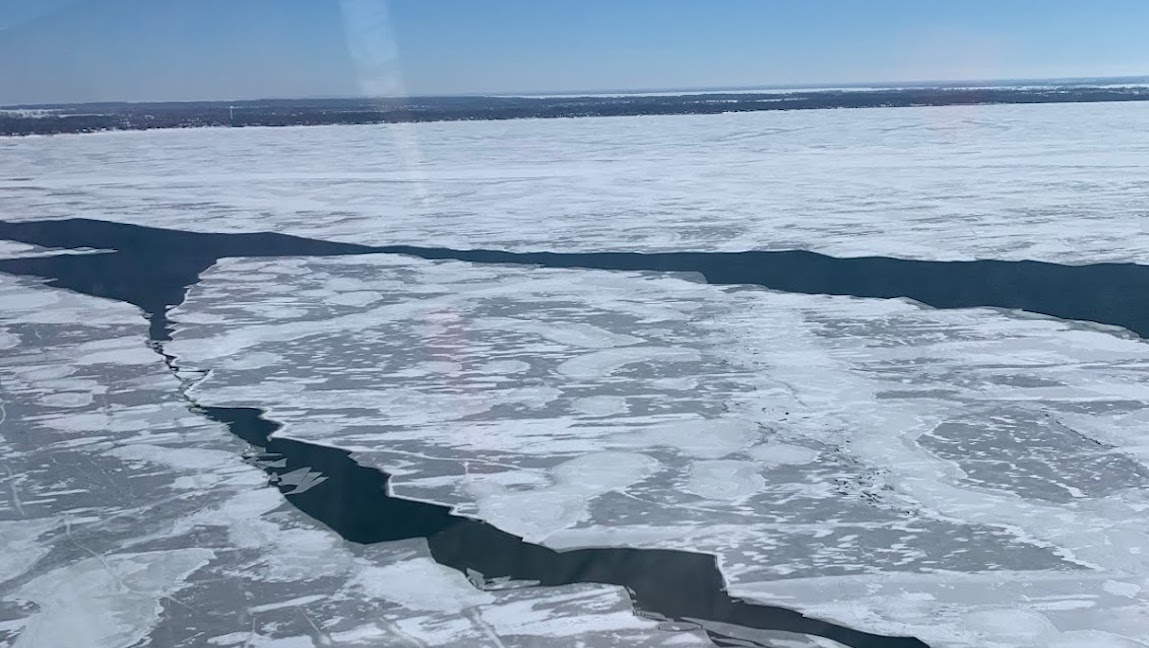A snowmobile trip off the shore of Northern Ohio’s Catawba Island recently turned into a daring rescue by helicopter and airboat when Lake Erie’s famed winter ice gave way, leaving 18 people stranded on an ice floe drifting away from the shore.
The snowmobilers were trapped for several hours last Sunday before being rescued by the U.S. Coast Guard and a “good Samaritan” with a boat. Though none required medical attention, the incident was another reminder of a growing problem in the Great Lakes region — its shrinking ice. Although conditions vary from winter to winter, average maximum ice cover on the lakes has fallen 22 percent over the last 50 years, according to the research group Climate Central.
The lakes are also staying frozen for less time each year, and the ice that does form is more unstable thanks to shifting climate patterns and water temperatures, said Jia Wang, a researcher with the National Oceanic and Atmospheric Administration’s Great Lakes Environmental Research Laboratory. Average temperatures in the Great Lakes region rose 2.3 degrees Fahrenheit between 1951 and 2017, according to NOAA, and Wang said that warm water temperatures carry over from previous years, creating a feedback loop that builds every winter. It causes ice to form later into the next winter season and leaves less time for it to build up in a thick layer.
Cold snaps like the one that froze 41 percent of the lakes’ surface in early February — after researchers initially predicted the region would experience its lowest ice cover in decades — can deposit just a thin sheet of ice, leaving it vulnerable to breaking, Wang said. Despite ice cover on Lake Erie reaching 92 percent the day before the snowmobilers’ stranding, the National Weather Service warned people to stay off the ice due to “hazardous conditions,” noting that several large cracks had already formed.
“It’s super dangerous out there,” U.S. Coast Guard Petty Officer Trent Gulliford told a Cleveland-area news station after the episode. “You don’t know how thick the ice can be or what lies underneath the snow or on top of the ice, so there is a lot to factor in.”
Incidents like the rescue are already becoming more common as the climate changes, Wang said. In January, 34 anglers had to be rescued when a chunk of ice broke away from the shore of Lake Michigan in Green Bay, Wisconsin. And Wang added that he expects to see similar situations in the future, though he cautioned that it’s hard to know what conditions will look like from year to year.
“It’s a chaotic natural system, which is very difficult to predict,” Wang said.
To learn more about what the future of the Great Lakes’ ice will look like, Wang will be participating in an upcoming research project sponsored by the University of Michigan and NOAA. Over a week in February, scientists from more than a dozen U.S. and Canadian institutions will sample ice and water from all five Great Lakes to understand how shrinking ice cover and warming temperatures are affecting “ice properties, water movement, nutrient concentrations and lake biology,” according to a press release.
“Winter is rapidly changing on the Great Lakes, but our ability to understand and predict the consequences of those changes is impeded by a shortage of winter-period studies on most aspects of Great Lakes limnology,” project leader Ted Ozersky, a biologist at the University of Minnesota, said in the release.



